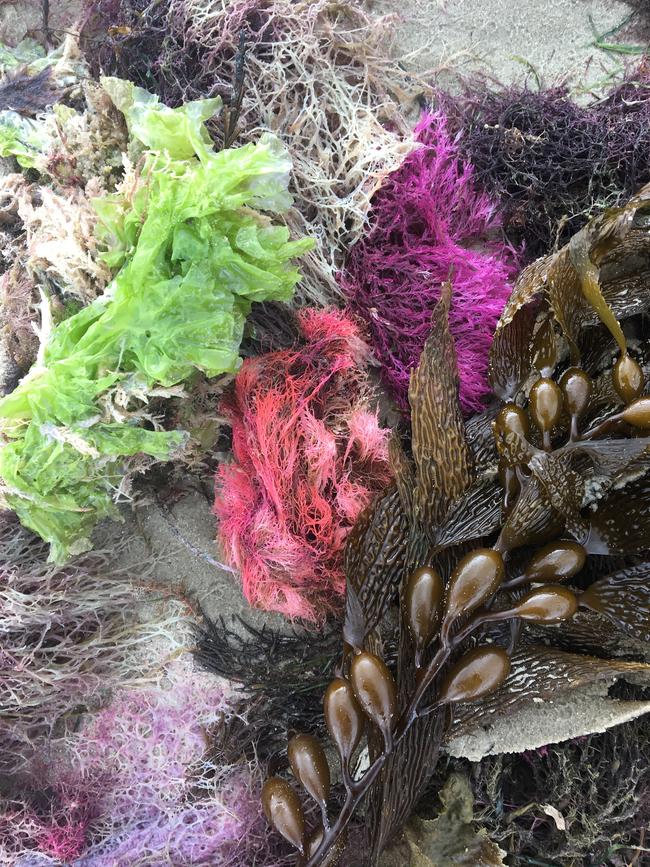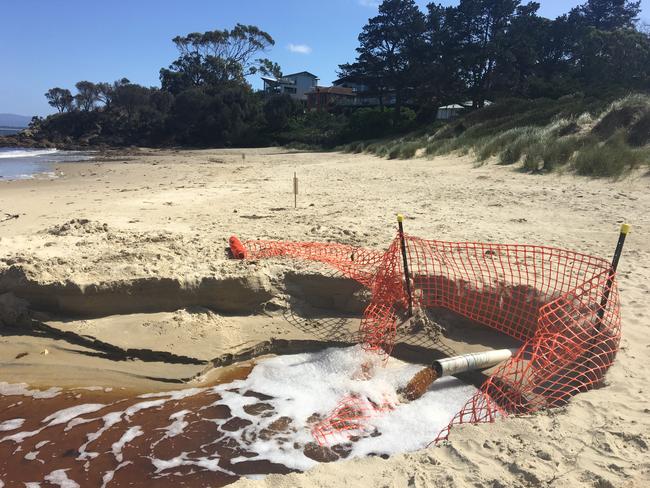Stormwater and septic tanks threatening our beaches
Imagine my shock this week at seeing an irrigation pipe in the middle of the beach, pumping stormwater — and potential faecal matter — straight into the ocean, writes Simon Bevilacqua.
Opinion
Don't miss out on the headlines from Opinion. Followed categories will be added to My News.
MY favourite memory of Red Ochre Beach is of snorkelling with my son about 10 years ago on a hot summer’s day.
He was much the same age as in this picture of him at that same Dodges Ferry beach.
We were exploring the sandy fringe of a rocky outcrop where fish and crabs ducked in and out of crevices and among the seaweed, which was like a blooming garden of colours, from an almost fluorescent orange to royal purple, lilac pink and lime green.
“Hey Dad,” he yelled excitedly through his snorkel. I pulled my head up and he was gesturing down in the water.
I took a breath and dived to swim to where he pointed. I met him a metre or so below the surface, his goggles failing to hide his exhilaration and awe. He was within touching distance of a seahorse.
I had not before seen one in the wild, and was struck by its shy expression and undeniable appearance of intelligence. Its head was noble, like a horse’s can be, and its lips seemed to pucker for kisses. Its engaging eyes returned our gaze in a kind manner that was familiar, reassuring.
Had this wonderful creature spoken, I would not have been entirely surprised.
Its lacelike fins, whatever they are, beat like a bee’s wings to move with graceful freedom. Gliding down in the garden, it wrapped its tail on a piece of weed and became imperceptible from its surrounds.
I reckon Red Ochre Beach is a magic and ancient nursery for the creation and care of childhoods, perfect for families.

Spectacle Head, a reef, and the Spectacle Islands protect it from southerly swells. The water is usually still as a pond. It’s a slow decline into the water, with no rips or currents, apart from in the wildest of seas. To locals, the end of the beach where we saw the seahorse is known as Blue Lagoon Beach, which I guess is a reference to the 1980 film featuring Brooke Shields and Christopher Atkins. Certainly there are days the beach has a paradisiacal feel.
Rich red ochre seams at the beach were highly valued by Tasmanian Aborigines prior to British invasion, with middens in the area full of it. Aboriginal men before colonisation often wore ochre in their hair. It was heated on a fire to turn it blood-red, scraped on a grindstone, and mixed with animal fat. The slurry dried hard as stone after being caked in the hair to form terracotta dreadlocks. French scientists in the 18th century described the men sorting out differences by growling at each other face-to-face and shaking their hair in a maraca-like rattle.
The British settlers and their descendants used the ochre to colour bricks right up to the middle of the 20th century.

IMAGINE my shock this week at seeing an irrigation pipe in the middle of the beach, pumping stormwater straight into the seahorse’s garden. A feeble attempt at orange plastic fencing surrounded the pipe, and makeshift signs stuck in the sand warned the beach was now unsafe for swimming.
It’s Sorell Council’s latest attempt in a decades-long battle to control a natural wetland system that has been around for as long as families have swum at Red Ochre.
A lagoon behind the dunes has a habit of drying up over summer and, depending on rainfall, becoming a boggy swamp or a lake in winter.
It is home to thousands of frogs that appear like magic after rain. Under a bright moon, the frogs create a symphony of bops and pops that sound like an electric hum from a distance. All sorts of birds, from ducks to black swans, use the lagoon.
In the 1950s, the lagoon was popular with holidayers. Waist-deep in places, children paddled rafts on it. Before colonisation, it had a water-release system in times of heavy rain.
Back then, dunes moved with the seasons and lagoon water would find a way through low-lying sand to the beach. The same system was at work on a beach I walked last week.
Stewarts Bay, near Port Arthur, has a trickle of brown water, about 1cm deep and 2m wide, seeping from the bush to the water’s edge. Follow the water trail into the bush and there’s a wonderful lagoon.
The problem at Red Ochre Beach, and so many other Tasmanian seasonal lagoons, is the weed, marram grass, holds the dunes together and stops the water’s march to the sea.
The only section water can get through is where people walk to the beach, and council had, in recent times, built a footpath, using timber and chains. This became a giant plug blocking the lagoon flow.
Council had to rip it out to release the water that had inundated public toilets at a nearby playground and threatened residents’ yards.
They then piped the water to Red Ochre. Surfers around the corner of Spectacle Head at Park Beach say the piped water creates a discernible slick as it passes the popular surf break.
Hundreds of homes behind Red Ochre Beach have septic tanks, many of which fail and can release faecal matter in the groundwater that ends up in the lagoon.
No scientific tests were done on the water now being released down the pipe. This month a council water quality report warned Red Ochre Beach already had problems due to septic run-off, and the issue was worsening.
Rumour is the council plans to pipe the lagoon water to an outlet near the Tiger Head boat ramp, apparently because people do not swim there and faecal-matter health concern are less of an issue. Hmmm.
Surely it is better to accept the lagoon as a living part of our landscape to be worked with rather than against?
Surely it is best to tackle septic run-off and stormwater at the source and use natural wetland filtration to advantage?
Surely it is time to get some scientific expertise in to design a long-term solution to ensure the environmental cycle of dry to bog to lagoon can last many more generations?
Or do we keep pumping our s--t into a seahorse’s garden?


